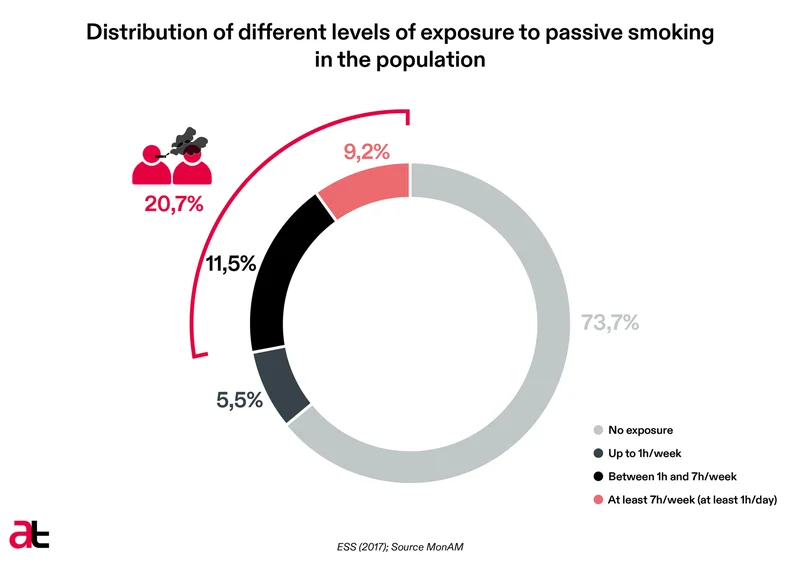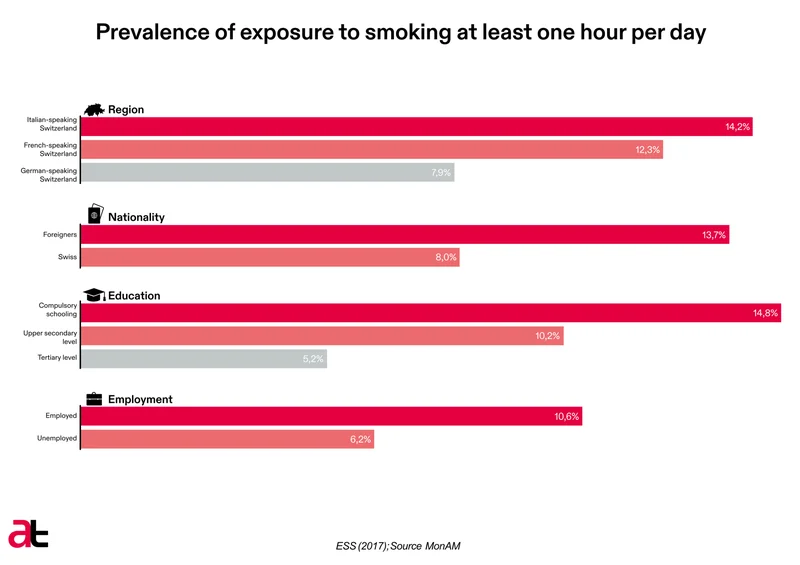Passive smoking
- 20.8% of the population age 15 and up is exposed to second-hand smoke for at least one hour per week; 9.2% is exposed an average of an hour per day.
- Those who receive the most exposure to second-hand smoke are young people, people with a low educational level (mandatory schooling only), foreigners, inhabitants of Italian-speaking and French-speaking parts of the country, and those who are actively employed.
Passive smoking, which is the result of direct exposure to the smoke from burning tobacco as well as to the smoke exhaled by smokers, also represents a significant public health problem. What is sometimes called “second-hand smoke” contains several thousand chemicals, hundreds of which are toxic, and at least 70 that are known to cause cancer[1] (for more detail about the effects and consequences of passive smoking, see our page Second-hand smoke).
Approximately one person in 10 is exposed an hour per day
Detailed statistics regarding the length of exposure to passive smoking are available in the system Monitoring Addiction and MNT (OBSAN, 2021[2]). These estimates, based on calculations from the Swiss health survey (ESS), do not distinguish between the exposure of smokers and that of non-smokers. They show that in 2017, while almost three-quarters – 73.7% – of the population age 15 and up reported never being exposed to second-hand smoke, more than one-fifth of the population – 20.7% – was in fact exposed to others' smoking at least an hour per week. The proportion of the population exposed an hour per day on average was 9.2% (Figure A3A-1). It should be noted that this figure is comparable to the level recorded by the ESS in 2012 (9.9%), but significantly lower than the 20.3% recorded in 2007 (three years prior to the application of legal measures at the national level against passive smoking).

Figure A3A-1 — Distribution (%) of different levels of exposure to second-hand smoke in the population (ESS 2017; Source MONAM[3]).
Certain subgroups of the population are clearly more exposed
The data from the ESS in 2017 also reveal significant differences in exposure to second-hand smoke as a function of age: people in the youngest age groups are clearly more likely to report an average exposure of an hour or more per day (22.7% of 20- to 24-year-olds, 20.6% of 15- to 19-year-olds, and 13.8% of 25- to 34-year-olds reported this). Similarly, people with the lowest educational levels (having completed only the required level of education or up to secondary II level), people actively employed, foreigners, and people living in Italian- and French-speaking Switzerland are significantly more exposed to passive smoking.

Figure A3A-2 – Prevalence of exposure to smoking at least one hour per day on average (%) according to linguistic region, nationality, educational level, and employment (ESS 2017; Source MONAM[4])
Exposure of non-smokers and other associated estimates
In an in-depth analysis of the data from the ESS, the OFS (Federal Statistics Office) shows that the proportion of non-smokers exposed at least one hour per day to passive smoking was 6% in 2017 (2020[5]). This was already the case in 2012, whereas it was still 16% in 2007. In spite of the fact that the ESS statistics do not allow us to directly infer the amount of second-hand smoke pregnant women, children, or adolescents are exposed to, it is estimated on the basis of the 2017 questionnaire that about one pregnant woman in eight smokes during pregnancy, and that, at a minimum, 27% of children and youths under 18 live with a parent who smokes.
Data regarding exposure to passive smoking by non-smokers have been published regularly in the context of Monitorage sur le tabac Suisse (Monitoring of Swiss tobacco use) (Keller et al., 2011[6]) and of the study CoRolAR of the Monitorage suisse des addictions (Swiss monitoring of addictions) (Gmel et al., 2017[7]).
[1] U.S. Department of Health and Human Services (2006). The Health Consequences of Involuntary Exposure to Tobacco Smoke - A Report of the Surgeon General. Atlanta, GA: U.S. Department of Health and Human Services, Centers for Disease Control and Prevention, National Center for Chronic Disease Prevention and Health Promotion, Office on Smoking and Health. Download.
[2] https://ind.obsan.admin.ch/fr/indicator/monam/tabagisme-passif-age-15; accessed 3.01.2022.
[3] https://ind.obsan.admin.ch/fr/indicator/monam/tabagisme-passif-age-15; accessed 3.01.2022.
[4] https://ind.obsan.admin.ch/fr/indicator/monam/tabagisme-passif-age-15; accessed 3.01.2022.
[5] OFS (2020) : Actualité OFS - Enquête suisse sur la santé 2017 – Consommation de tabac en suisse. OFS. Neuchâtel. Download.
[6] Keller, Roger; Radtke, Theda; Krebs, Hans; Hornung, Rainer (2011): Der Tabakkonsum der Schweizer Wohnbevölkerung in den Jahren 2001 bis 2010. Tabakmonitoring - Schweizerische Umfrage zum Tabakkonsum. Download.
[7] Gmel, Gerhard; Kuendig, Hervé; Notari, Luca; Gmel, Christiane (2017): Monitorage suisse des addictions Consommation d’alcool, de tabac et de drogues illégales en Suisse en 2016. Sucht Schweiz. Lausanne. Download.
AT Switzerland, September 2022